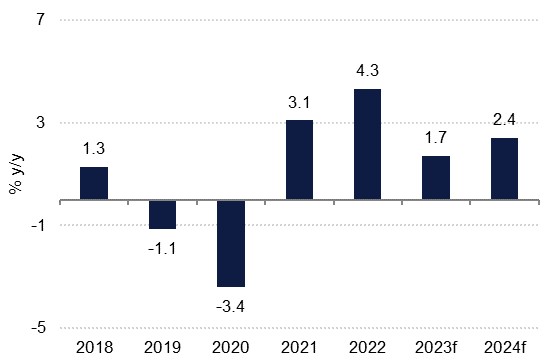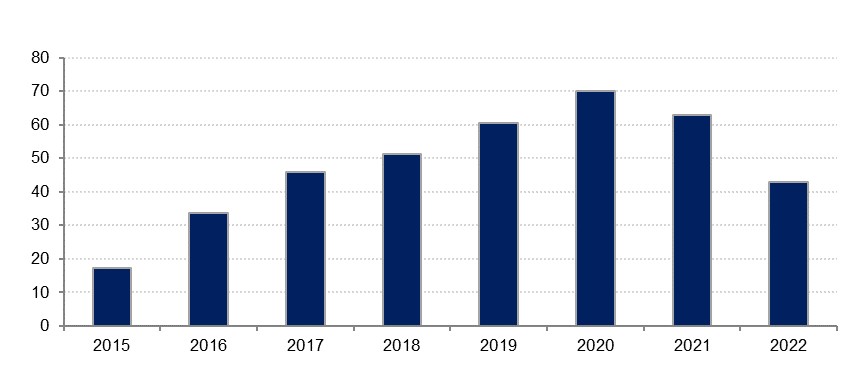
We forecast real GDP growth of 1.7% in Oman this year, following 4.3% in 2022. This is a downgrade from our earlier forecast of 2.8% growth, but – as with the rest of the GCC – this downward revision stems from the voluntary oil production curbs being implemented as part of the OPEC+ grouping. The outlook for the non-oil sector remains positive, buoyed by government infrastructure spending, a surge in tourist arrivals, and falling inflation.
Oman recorded headline real GDP growth of 4.3% in 2022, the strongest rate of expansion since 2016. Growth was driven by the hydrocarbon sector which expanded 10.2% and totals just over a third of GDP (oil accounted for 29.2% last year, with natural gas providing an extra 5.0%). Oil GDP grew 11.0%, similar to the double-digit gains seen elsewhere in the GCC, while natural gas expanded 5.9%. The non-oil sector was the laggard in 2022 as it grew 1.6%: standout sectors were restaurants & hotels which recorded growth of 17.3%, while manufacturing expanded 28.9%, with manufacturing of chemical and petroleum products growing at a far slower rate. Headline growth was weighed down by a 23.2% contraction in building & construction, however, which accounted for 7.0% of GDP last year, down from 11.2% in 2020.

As with the rest of the GCC, our expectation is that the dynamics of growth in Oman will be reversed this year due to the voluntary cut of 40,000 b/d that the country began in May and intends to continue through to the end of 2024 as things stand. Crude oil production averaged 1.07mn b/d in the first quarter, some 30,000 b/d greater than in Q1 last year, but our expectation over the year is now that oil production will be 3.0% lower in 2022, informing our forecast that hydrocarbon GDP will contract by 2.0%. Upside risk to this outlook stems from the natural gas sector, as LNG exports hit a record high in April amid ongoing investment in building capacity. A new integrated gas firm to manage the sector will contribute to this.
For non-oil GDP, we forecast growth of 3.5% this year, with positive momentum in a range of sectors set to underpin the more rapid expansion. One of these is tourism, with the sector bouncing back from the Covid-19 pandemic last year with 2.9mn visitors, marking an increase of 348% y/y and contributing to the 17.3% growth in restaurants & hotels GDP. 2023 got off to a strong start with 177% y/y growth in visitors in January, and ongoing investment as part of the Oman Vision 2040 plan will help support this over the coming quarters with numerous new projects earmarked for the next two years and plans to collaborate with Saudi Arabia in the kingdom’s tourism development through the potential launch of a joint tourist visa and boosting regional flights.
Nearly two thirds of the visitors to Oman last year came from the UAE, and the development of the rail network between the two countries will help facilitate ongoing growth in these numbers in the years ahead. Oman Rail and Etihad Rail have an agreement to develop the rail network from the UAE to Oman, which once passenger services are launched will make leisure travel between the two countries easier as it introduces travel times of 100 minutes between Abu Dhabi and the Omani port of Sohar.
Crucially, the development of the railway will also buttress another key development industry in Oman, namely logistics, which has been earmarked by the Omani government as a key target sector to support economic diversification from hydrocarbons. Transport & communication GDP grew 16.3% last year, with the port of Salalah handling 18.4mn freight tons (FRT) in general cargo, up 8.9% from 16.9mn FRT the previous year.
While the global slowdown poses some downside risk to trade flows as this year goes on, the port has got off to a strong start with Q1 cargo up 11.8%. The number of containers handled by Salalah has been almost flat by comparison over the past couple of years, but at 4.5mn TEUs over the course of 2022 it remains a sizeable facility (44th busiest globally last year), taking advantage of its enviable position on a number of major shipping lanes.

The ongoing growth of new sectors will support new jobs in Oman, with the labour market having rebounded strongly since the pandemic. The number of insured private sector employees stood at 277,589 in April, a new high for the measure and up from 261,176 in April 2020. This will support private consumption in Oman, as will falling CPI inflation, which we forecast will average 1.0% this year, from 2.8% in 2022.
Oman is arguably in a stronger growth position thanks in part to a marked improvement in its fiscal conditions over the past several years. We estimate that Oman ran a budget surplus equivalent to 4.0% of GDP in 2022, its first in over 15 years, as the GCC benefitted from higher oil prices and a ramp-up in production. Oil revenues are set to be lower this year, but with a fall in expenditure also anticipated as the integrated gas company means transportation expenses fall away, the budget will be only moderately negative, at -0.1% in 2023 according to our forecasts, and returning to surplus at 1.0% in 2024. The government has tempered any increase in its untargeted spending even as oil prices surged, instead focusing on a series of infrastructure projects that are aimed at supporting the economic diversification programme.

After ramping up rapidly in the years after the oil price collapse in H2 2014, government debt peaked at 70.0% of GDP in 2020 as the Covid-19 pandemic struck and oil demand fell off a cliff. However, there has been solid progress in bringing debt down while conditions have been more favourable, and it fell to 40.1% last year and the government has paid off a further USD 2.9bn in loans in the first quarter. This progress has led to a series of upgrades from the major ratings agencies, as Moody’s upgraded its credit rating for Oman from Ba3 to Ba2 with a positive outlook last month, edging it closer to investment grade once again.
